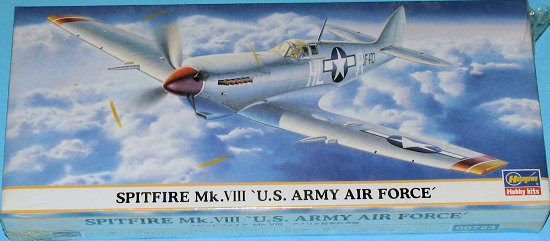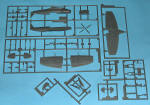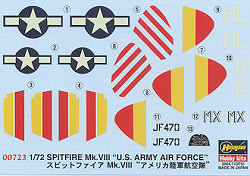
| KIT: | Hasegawa 1/72 Spitfire Mk VIII 'US Army Air Force' |
| KIT #: | 00723 |
| PRICE: | $15.95 at GreatModels |
| DECALS: | Two options |
| REVIEWER: | Scott Van Aken |
| NOTES: | 2004 boxing |

| HISTORY |
It often happens that a stop-gap measure ends up being more widely used than the often delayed version. This is what happened in regards to the Spitfire VIII. Delays in getting the aircraft in production resulted in the Spitfire IX, which used extant airframes of Mk V's (which were often rebuilds of Mk I and Mk II aircraft) along with the new Merlin 61 engine to get the plane into the hands of pilots. Sure, Mk. IX aircraft were built brand new, but they were supposed to be the Mk. VIII.
The Mk VIII came about in a rather different manner. They were supposed to be low altitude derivatives of the Spitfire VI and VII high altitude fighter, but without the cockpit pressurization and the extended wing tips (though some were built with them as high altitude fighters. Go figure). The Mk. VIII can be distinguished from its hybrid Mk. IX cousin by the retractable tail wheel and additional doors. In most other respects, the airframes are the same. Thanks to the head start of the Mk IX, only 1650 Mk. VIII were built, compared to over 5,600 Mk. IXs. Many of the Mk VIII aircraft were used by Britain's allies, mainly the US and Australia. Principally, they were used in the Mediterranean as well as Burma and the Southwest Pacific.
| THE KIT |
 Pop open the box and you see what one
expects from a Hasegawa 1/72 kit; a bunch of different sprues. Now this isn't a
new kit, but
little has changed at the house of Hasegawa. You still have nicely engraved
panel lines; you still have a bunch of interchangeable sprues to make sure that
you can do only the kit boxed, and you still have those nice decals where white
is closer to ivory.
Pop open the box and you see what one
expects from a Hasegawa 1/72 kit; a bunch of different sprues. Now this isn't a
new kit, but
little has changed at the house of Hasegawa. You still have nicely engraved
panel lines; you still have a bunch of interchangeable sprues to make sure that
you can do only the kit boxed, and you still have those nice decals where white
is closer to ivory.
Doing the usual intensive scan of the parts for things like ejector pin marks, flash and sink areas, I find two of the three. As usual, the ejector pin marks are on the inside of gear doors, landing gear legs, the center of the seat pan, and the back of the wheels. Sink areas are on the other side of the gear doors. The cockpit is adequate for the job with a floor, seat, control stick, as well as fore and aft bulkheads. The fore bulkhead has the blank instrument panel face awaiting its decal. Other items of interest are the large centerline tank that gave great range but also a huge speed and maneuverability penalty. It was rarely used in combat. There are also separate exhaust doors for the coolers.
You also get a separate 'fixed' tail wheel in case you
may want to do a Mk IX from this kit. Separate wing tips allow even more
options. You are pretty well confined to a later Mk IX should you choose that
way to go as the rudder is the more peaked version and the elevators are the
later versions with more area. The canopy (not shown) is still a single piece so
it is off to vacuform land if you want yours open to show the rather Spartan
cockpit. 
Instructions are what we have come to expect from Hasegawa. Well drawn, unambiguous as to where things are to be placed with ready color references. As has been the case for the last 20 years or more, these are from the Gunze line, and if Gunze doesn't make it, you'll have to mix it. Decals are for two options. First is the box art aircraft in Light Aircraft Grey over Azure, a color scheme I have recently learned was used by the 31st FG, this being from the 308th FS. Wing tip bands are red and yellow with the red inboard. Frankly, I'd paint them on. Same with the other option in overall silver (or perhaps unpainted metal). This 307th FS aircraft has the tip colors reversed and a set of red stripes on its fin/rudder. This option uses the longer wing tips. Decals seem to be the 'old' style with white that is a bit on the ivory side and red that is to orange for my tastes.
| CONCLUSIONS |
Though I've probably seen this kit built, it hasn't registered. Too often I see a Spitfire and gloss over it. It is just the nature of the beast and I have no excuse. Previously, the only Mk VIII in 1/72 that I can recall seeing with any regularity was the Frog/Nove version that has undoubtedly been re-boxed a zillion times under a number of labels. I'd bet that Italeri has done one as well since they do a Mk IX. This is the kind of kit that one pays a bit too much for and then is able to put it together rather quickly, resulting in a very nice model. I know my old Frog Mk.VIII is due for a replacement and this one will do nicely, thank you!
You can find this and other fine Hasegawa kits at GreatModels
January 2007
If you would like your product reviewed fairly and quickly by a site that has nearly 350,000 visitors a month, please contact me or see other details in the Note to Contributors.